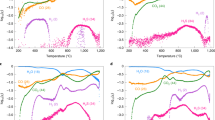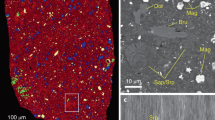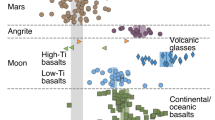Abstract
THE effects of cosmic radiation on meteorites have been studied thoroughly during the past 15 yr1,2. 14C is chiefly produced by three nuclear reactions: 14N(n,p)14C, 16O(p,3p)14C and 16O(n,2pn)14C. The first reaction occurs in the Earth's atmosphere3–4 and provides the basis for the well known radiocarbon dating method. The 14N(n,p)14C reaction has its largest cross-sections (σ=1.7 bar) in the thermal neutron energy region. The 16O spallation reactions (σ=2 mbar) require energies above 10 MeV. The air mass of 1 kg cm−2 above the surface of the Earth dissipates most of the energy of the primary cosmic rays. Therefore, 14C production in rocks on the Earth's surface is negligible. The surface of an object in space, however, is exposed to the full flux of the primary cosmic radiation. Meteorites, therefore, contain a measurable amount of high-energy spallation products. Meteorites contain very little nitrogen, and hence the 14C production is dominated by 16O spallation. The equilibrium 14C activity in stony meteorites per unit weight has a different value from that of the terrestrial atmosphere. The approximate average values for the 14C production rate are 120 14C atoms min−1 cm2 at the Earth's surface (containing 1 kg of air) and 60 14C atoms min−1 kg of meteorite5.
This is a preview of subscription content, access via your institution
Access options
Subscribe to this journal
Receive 51 print issues and online access
$199.00 per year
only $3.90 per issue
Buy this article
- Purchase on Springer Link
- Instant access to full article PDF
Prices may be subject to local taxes which are calculated during checkout
Similar content being viewed by others
References
Honda, M., and Arnold, J. R., Handbuch der Physik., 46/2, 613 (1967).
Arnold, J. R., Honda, M., and Lal, D., J. Geophys. Res., 66, 3519 (1961).
Lingenfelter, R. E., Rev. Geophys., 1, 35 (1963).
Libby, W. F., Radiocarbon Dating (University of Chicago Press, 1955).
Goel, P. S., and Kohman, T. P., Science, 136, 875 (1962).
Boeckl, R. S. (in the press, 1971).
Shedlovsky, J. P., Honda, M., Reedy, R. C., Evans, J. C., Lal, D., Lindstrom, R. M., Delany, A. C., Arnold, J. R., Loosli, H. H., Fruchter, J. S., and Finkel, R. C., Science, 167, 574 (1970).
Finkel, R. C., Arnold, J. R., Reedy, R. C., Fruchter, J. S., Loosli, H. H., Evans, J. C., Shedlovsky, J. P., and Delany, A. C., Second Ann. Lunar Science Conference. (Houston, 1971).
Hubbs, C. L., and Bien, G. S., Radiocarbon, 9, 261 (1967).
Suess, H. E., and Wänke, H., Geochim. Cosmochim. Acta., 26, 475 (1962).
Vogt, J. R., and Ehmann, W. D., Radiochim. Acta, 4, 24 (1965).
Wänke, H., Begeman, F., Vilcsek, E., Rieder, R., Teschke, F., Born, W., Quijano-Rico, M., and Wlotzka, F., Science., 167, 523 (1970).
Author information
Authors and Affiliations
Rights and permissions
About this article
Cite this article
BOECKL, R. Terrestrial Age of Nineteen Stony Meteorites derived from their Radiocarbon Content. Nature 236, 25–26 (1972). https://doi.org/10.1038/236025a0
Received:
Revised:
Issue Date:
DOI: https://doi.org/10.1038/236025a0
This article is cited by
-
The history of ordinary chondrites from the data on stable isotopes of noble gases (a review)
Solar System Research (2005)
-
Antarktische Meteorite
Naturwissenschaften (1982)
-
Thermoluminescence and terrestrial age of the Estacado meteorite
Nature (1978)
-
The association of nonthermal electrons with non-flaring coronal transients
Solar Physics (1978)
Comments
By submitting a comment you agree to abide by our Terms and Community Guidelines. If you find something abusive or that does not comply with our terms or guidelines please flag it as inappropriate.



